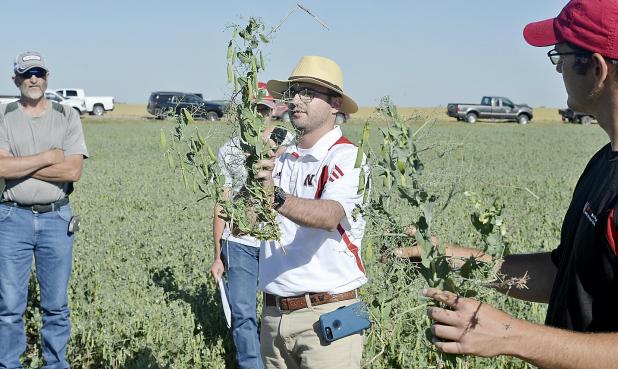
UNL cropping specialist Rodrigo Werle of North Platte, center, and cropping specialist Strahinja Stepanovic of Grant, right, display some pea plants during a field tour June 20 held by the Henry J. Stumpf International Wheat Center at Grant. (Johnson Publications photo)
Field pea research continues to evolve
Research on field peas as an additional dryland rotational crop continues to evolve.
Crop researchers with the University of Nebraska and Kansas State University shared their ongoing work during a field day June 20.
More dryland farmers are considering field peas as a rotational crop.
Researchers have proven that farmers can implement a wheat-corn-field pea rotation. Without peas in the rotation, ground sits idle one year out of three.
During the field day, tour participants visited a university plot site northwest of Brandon on land owned by Steve Tucker of Venango.
Tucker has been an early adopter of growing field peas and also grows certified field pea seed with Jeff Olsen of Imperial.
He has also worked closely with the university on their research.
The field pea plot tour was followed by a wheat plot tour at the Henry J. Stumpf International Wheat Center just outside of Grant.
The afternoon session at the center was highlighted by roundtable discussions on peas and wheat.
Plant early to beat heat
Cropping Specialist Rodrigo Werle said planting early represents one of the key factors in field pea.
By early, he means late March or early April. The earlier, the better, he said.
The field pea plant will put on flowers anywhere from 55-64 days after planting. Plant too late and those flowers can get hammered by high temperatures.
Werle said temperatures above 85°F will hurt the flowering process and reduce yield.
On their plot near Brandon, Werle said peas planted on March 17 were done flowering before hot temperatures hit. As a result, the plants are in good condition.
Peas planted in early April fared well but those planted in late April got hit with heat right as they began flowering.
Seed handling, population
Strahinja Stepanovic, UNL cropping specialist at the Stumpf Center, has been actively involved in the pea research as well.
He impressed on farmers that pea seed is especially sensitive. Each time the seed gets handled, it loses some germination quality.
While it’s not a scientific finding, Stepanovic said Kansas pea farmers swear that each time the seed touches iron, its germination decreases by 5 percent.
Use of steel augers when handling pea seed is not recommended.
Lucas Haag, agronomist at Kansas State’s Extension Center in Colby, said the minimum seeding rate is 350,000 seeds per acre. In 2016, they tested rates as high as 500,000 seeds per acre.
They have seven years of yield data on field peas at their Colby site. Yields have ranged as high as 56 bushels in 2016 to a low of 8 bushels in 2012.
To view more please log in or subscribe to the digital edition. https://etypeservices.com/Imperial%20RepublicanID359/
